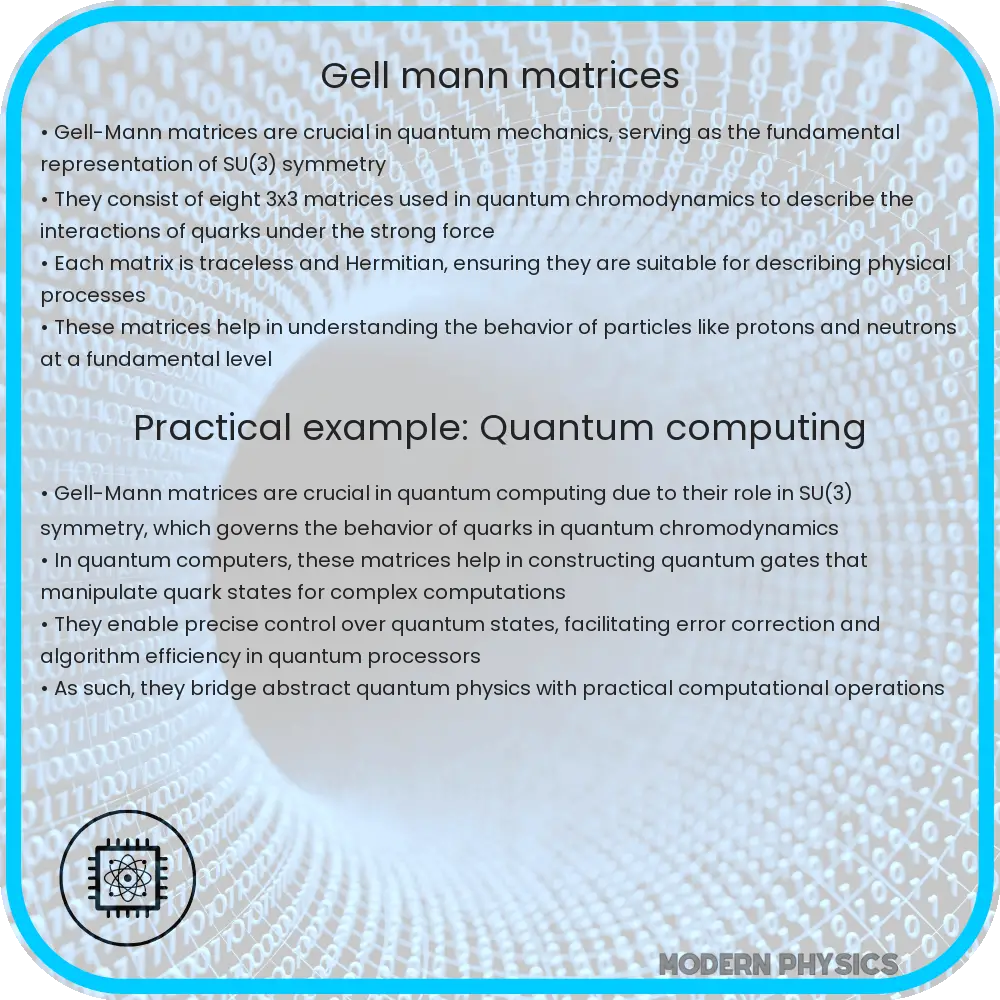Gell-Mann matrices are a set of eight 3×3 traceless, Hermitian matrices used as generators for the SU-3 group in quantum chromodynamics.

Understanding Gell-Mann Matrices: Foundations in Quantum Field Theory
Quantum Field Theory (QFT) lays the framework for understanding the fundamental particles and forces that govern the universe. One of the key concepts in QFT is the idea of symmetries, particularly those described by the special unitary group known as SU-3. This symmetry is crucial in the study of quantum chromodynamics (QCD), the theory that deals with the strong interaction which binds quarks together inside protons, neutrons, and other particles. Central to these studies are the Gell-Mann matrices, which play an analogous role in SU(3) to the role played by Pauli matrices in SU(2) symmetry.
What are Gell-Mann Matrices?
Gell-Mann matrices, named after physicist Murray Gell-Mann, are a set of eight matrices used to represent the generators of the SU(3) group in QCD. These matrices are vital for understanding the behavior of quarks under SU(3) symmetry. Each matrix is 3×3, traceless, Hermitian, and can be represented as follows:
- λ1 =
\(\begin{pmatrix}
0 & 1 & 0 \\
1 & 0 & 0 \\
0 & 0 & 0 \\
\end{pmatrix}\) - λ2 =
\(\begin{pmatrix}
0 & -i & 0 \\
i & 0 & 0 \\
0 & 0 & 0 \\
\end{pmatrix}\) - λ3 =
\(\begin{pmatrix}
1 & 0 & 0 \\
0 & -1 & 0 \\
0 & 0 & 0 \\
\end{pmatrix}\) - λ4 =
\(\begin{pmatrix}
0 & 0 & 1 \\
0 & 0 & 0 \\
1 & 0 & 0 \\
\end{pmatrix}\) - λ5 =
\(\begin{pmatrix}
0 & 0 & -i \\
0 & 0 & 0 \\
i & 0 & 0 \\
\end{pmatrix}\) - λ6 =
\(\begin{pmatrix}
0 & 0 & 0 \\
0 & 0 & 1 \\
0 & 1 & 0 \\
\end{pmatrix}\) - λ7 =
\(\begin{pmatrix}
0 & 0 & 0 \\
0 & 0 & -i \\
0 & i & 0 \\
\end{pmatrix}\) - λ8 =
\(\frac{1}{\sqrt{3}}\)
\(\begin{pmatrix}
1 & 0 & 0 \\
0 & 1 & 0 \\
0 & 0 & -2 \\
\end{pmatrix}\)
These matrices are not only mathematical constructs but also have real physical implications. They are used to explain the different charge states and colors of quarks, which are fundamental aspects of particle interactions mediated by gluons in the context of the Standard Model of particle physics.
Role of SU-3 Symmetry in Particle Physics
SU-3 symmetry describes the color charge in quark interactions. Unlike electric charge, color charge comes in three types—red, green, and blue—and their corresponding anti-colors. The Gell-Mann matrices allow us to mathematically define and manipulate these colors in theoretical frameworks. In QCD, these color charges and their dynamics are crucial for explaining phenomena such as the binding of quarks within protons and neutrons and the interactions that occur in high-energy particle collisions.
The algebra of Gell-Mann matrices, which involves their commutation relations, is fundamental in defining the gluon interactions that hold quarks together in a nucleus. This not only affects our understanding of nucleon structure but also has wider implications in the study of the universe’s fundamental forces.
Understanding the mathematical underpinnings, like the Gell-Mann matrices, provides physicists and students with essential tools to delve deeper into the behavior of particles at the smallest scales, exploring how the universe fundamentally works at a subatomic level. By continuing to explore these symmetries, researchers can further uncover the intricacies of the universe.
Applications in Modern Physics and Technology
The Gell-Mann matrices and SU-3 symmetry have applications that go beyond pure theoretical physics. They are instrumental in advanced simulations and models that predict particle behavior in accelerators like the Large Hadron Collider (LHC). These tools help physicists in experimental setups to identify new particles and gain insights into the early moments of the universe immediately after the Big Bang.
Furthermore, understanding these matrices is crucial for the development of quantum computing and quantum information theory. The properties of these matrices, such as commutation, are analogous to logic operations in classical computing but operate in the quantum realm, potentially leading to new breakthroughs in computational speed and security.
The Impact of Quantum Chromodynamics
Quantum Chromodynamics (QCD) as supported by the Gell-Mann matrices has profoundly impacted our comprehension of the universe’s fundamental structure. It explains not only the stability of atomic nuclei but also the existence of exotic states of matter such as quark-gluon plasma, thought to exist in the cores of neutron stars and during the universe’s early stages. This expands our perspective on matter and the universe, pointing to new physics beyond the current models.
QCD also plays a critical role in cosmology, helping explain how matter behaved at extreme energies and temperatures, offering insights critical to understanding the evolution of the universe. Technologically, the principles of QCD inform the development of new materials and the exploration of energy sources, potentially leading to revolutionary changes in technology and industry.
Conclusion
The Gell-Mann matrices are more than just a mathematical curiosity; they are a fundamental part of modern physics, deeply embedded in the theory that describes the most elemental constituents of matter. As a cornerstone of Quantum Chromodynamics, these matrices not only enhance our understanding of the atomic and subatomic world but also offer promising avenues for technological advancements in quantum computing and materials science. Continuing to study and explore these matrices and their implications allows scientists to push the boundaries of what is known and to discover what remains in the mysterious quantum realm. This journey of discovery not only illuminates the intricacies of the universe at its most fundamental but also propels humanity forward towards technological innovations and deeper understanding of the cosmos.
